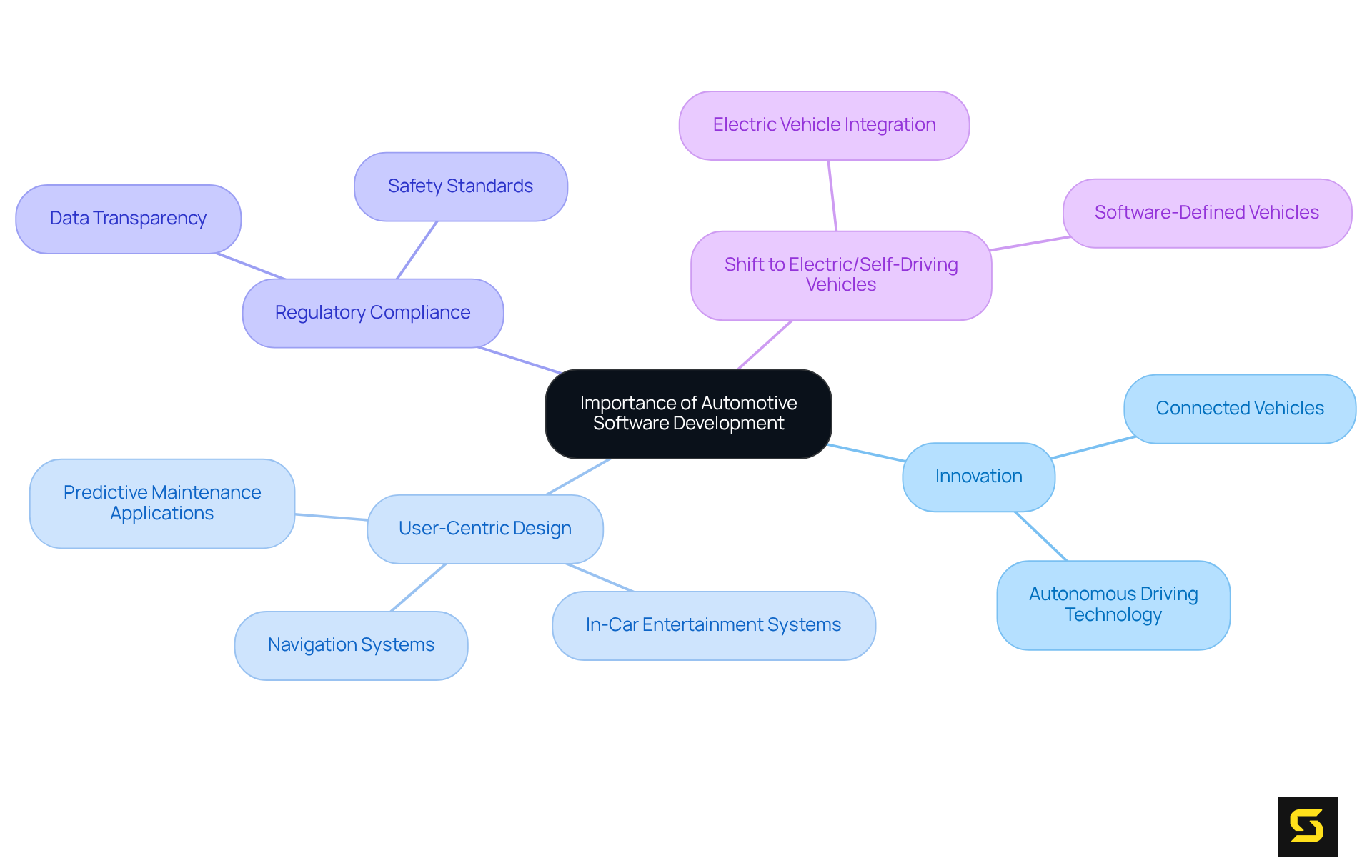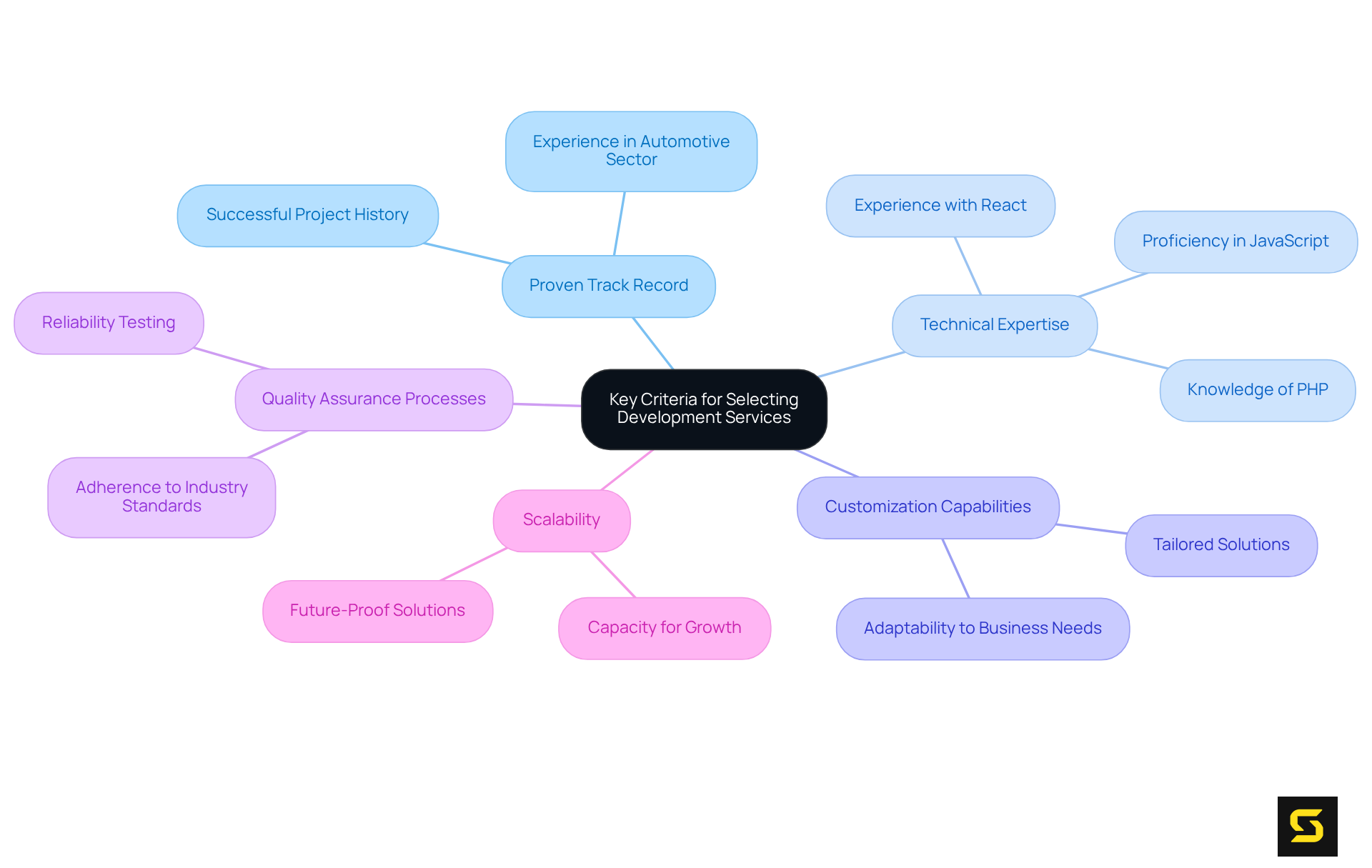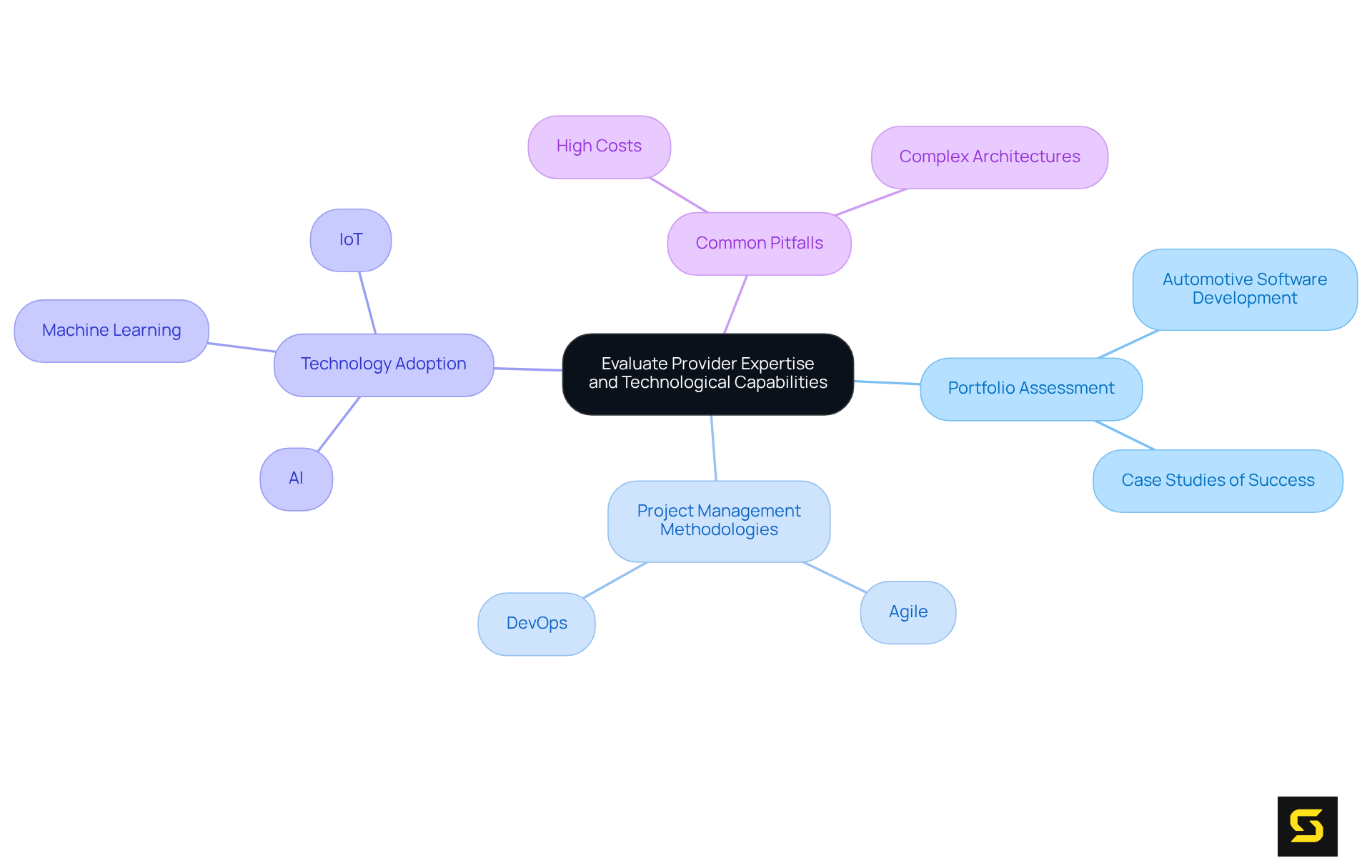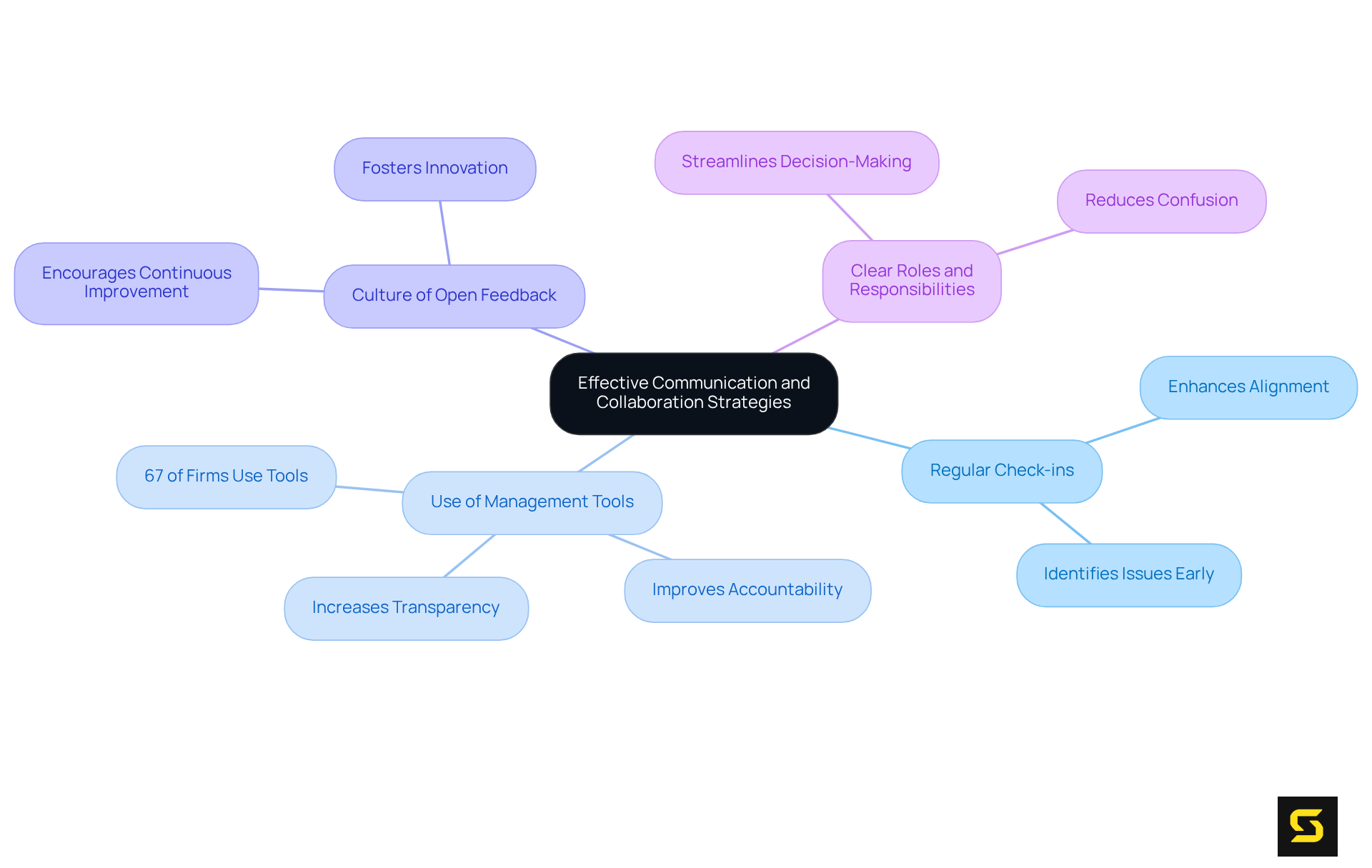Overview
Mastering automotive software development services is essential for achieving success in the SaaS sector, especially as the industry shifts toward more connected and autonomous vehicles. This assertion is underscored by the critical role of user-centric design, technical expertise, and effective communication strategies. Together, these elements significantly enhance vehicle performance, safety, and user experience, establishing a solid foundation for future advancements in the field.
Introduction
The automotive industry is experiencing a significant transformation, with software development emerging as a pivotal force driving innovation and safety in contemporary vehicles. As cars evolve into intricate, connected machines, the demand for superior automotive software development services has reached unprecedented levels. This article explores the essential strategies and best practices that SaaS providers can implement to navigate this intricate landscape, ensuring they not only comply with regulatory standards but also surpass user expectations.
How can organizations effectively select and collaborate with development partners to fully leverage the potential of automotive technology while steering clear of common pitfalls?
Understand the Importance of Automotive Software Development
In today's technology-driven landscape, automotive programming stands as a cornerstone of innovation, especially as vehicles evolve into more connected and autonomous entities. The seamless integration of advanced technological solutions not only boosts vehicle performance but also significantly enhances safety and user experience.
For SaaS providers within the automotive sector, leveraging robust development services can yield substantial competitive advantages. By prioritizing user-centric design and functionality, companies can develop applications that not only comply with regulatory standards but also surpass customer expectations.
This emphasis on excellence is particularly critical as the automotive industry shifts towards electric and self-driving vehicles, where sophisticated programming is essential for optimal functionality and user engagement. Noteworthy examples include:
- Navigation systems
- Predictive maintenance applications
- In-car entertainment systems
All of which rely heavily on cutting-edge technological solutions to operate effectively. Embrace the future of automotive technology; the time to act is now.

Identify Key Criteria for Selecting Development Services
When selecting automotive software development services, organizations must consider several pivotal criteria. First, automotive software development services are essential as providers with a proven track record in the automotive sector comprehend the unique challenges and requirements inherent to this field. Next, Technical Expertise is crucial—ensure the provider demonstrates proficiency in relevant technologies such as JavaScript, React, and PHP, which are vital for developing dynamic applications. Furthermore, Customization Capabilities play a significant role; the ability to tailor solutions to meet specific business needs is indispensable. Additionally, robust Quality Assurance Processes are necessary to guarantee that the application is reliable and adheres to industry standards. Lastly, consider Scalability; the chosen solution must be capable of evolving alongside the business, accommodating future needs without necessitating a complete overhaul. By applying these criteria, organizations can make informed decisions that foster successful partnerships.

Evaluate Provider Expertise and Technological Capabilities
To effectively evaluate a development provider, organizations must rigorously assess both their expertise and technological capabilities. A comprehensive evaluation of their portfolio is essential to understand the types of assignments they have successfully completed, particularly those related to automotive software development services. Seek out case studies that demonstrate their proficiency in addressing complex challenges and delivering innovative solutions. Notably, the market for automotive software development services is projected to grow at a CAGR of 13.1% from 2025 to 2032, underscoring the increasing demand for skilled suppliers.
Moreover, inquire about their project management methodologies, such as Agile or DevOps, as these approaches can significantly influence project timelines and flexibility. It is also crucial to grasp a provider's stance on technology adoption. They should possess a robust understanding of emerging technologies like AI, machine learning, and IoT, which are becoming increasingly vital in automotive software development services. Engaging in discussions regarding their development processes and tools can yield valuable insights into their operational efficiency and commitment to quality.
Additionally, it is imperative to recognize common pitfalls in evaluating service providers. High investment costs and complex system architectures are substantial factors that can hinder growth in the vehicle application market. By prioritizing these assessments and considering the growing complexity of vehicle technology, organizations can enhance their chances of selecting a provider for automotive software development services that aligns with their goals and fosters successful outcomes in automotive technology development.

Establish Effective Communication and Collaboration Strategies
Efficient communication and cooperation approaches are vital for the success of automotive software development services initiatives. Organizations must implement regular check-ins and updates to ensure all stakeholders align on objectives and timelines. Utilizing management tools such as Jira or Trello significantly enhances transparency and accountability among team members; in fact, 67% of firms leverage management applications for client communication.
Furthermore, fostering a culture of open feedback is essential for encouraging continuous improvement and innovation. As Bradford Winters aptly stated, "Effective communication is the best way to solve problems." It is equally important to define clear roles and responsibilities within the team to streamline decision-making processes.
By prioritizing communication and collaboration, organizations can effectively mitigate risks and elevate the overall quality of automotive software development services. Moreover, effective communication and teamwork can reduce project timelines, as indicated by 70% of respondents who observed these practices resulting in enhanced efficiency. Addressing common pitfalls in communication—such as unclear expectations and lack of engagement—can further improve project outcomes.

Conclusion
The realm of automotive software development is pivotal for driving innovation and enhancing the user experience in an increasingly connected and autonomous vehicle landscape. As the industry transitions towards electric and self-driving technologies, the need for robust software solutions becomes even more pronounced. Companies that focus on user-centric design and advanced functionality not only meet regulatory standards but also exceed customer expectations, positioning themselves for success in a competitive market.
Key considerations for selecting the right automotive software development services include:
- Assessing provider expertise
- Technological capabilities
- The ability to customize solutions
Organizations should prioritize partnerships with providers that demonstrate a strong track record in the automotive sector, possess the necessary technical skills, and maintain rigorous quality assurance processes. Furthermore, effective communication and collaboration strategies are essential to streamline project execution and foster innovation, ultimately leading to successful outcomes.
In conclusion, as the demand for automotive software development services continues to grow, embracing these best practices will be crucial for organizations aiming to thrive in this dynamic environment. By prioritizing strategic partnerships, investing in the right technologies, and fostering effective communication, businesses can navigate the complexities of automotive software development while contributing to shaping the future of the industry. The time to act is now; the road to SaaS success in automotive software development is paved with informed choices and collaborative efforts.
Frequently Asked Questions
Why is automotive software development important?
Automotive software development is crucial as it enhances vehicle performance, safety, and user experience, especially as vehicles become more connected and autonomous.
How can SaaS providers benefit from automotive software development?
SaaS providers can gain substantial competitive advantages by leveraging robust development services that prioritize user-centric design and functionality, enabling them to meet regulatory standards and exceed customer expectations.
What role does software play in the evolution of electric and self-driving vehicles?
Sophisticated programming is essential for the optimal functionality and user engagement of electric and self-driving vehicles, making software development a critical component of this evolution.
What are some examples of applications that rely on automotive software?
Notable examples include navigation systems, predictive maintenance applications, and in-car entertainment systems, all of which depend on advanced technological solutions for effective operation.
What is the current trend in the automotive industry regarding technology?
The automotive industry is increasingly shifting towards electric and self-driving vehicles, necessitating a focus on advanced software development to keep pace with innovation.





